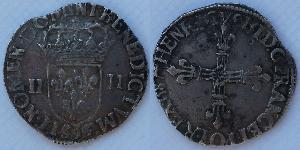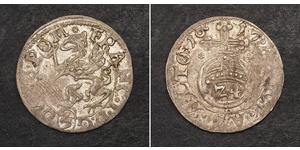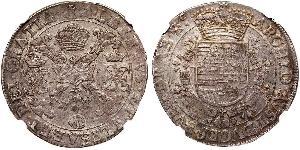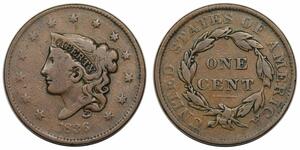(продана за $14.0)
1550, Royal France, Henry II. Medieval Silver Douzain Coin. Dijon mint!
Mint Year: 1550
Mint Place: Dijon (P)
References: Duplessy 997, C. 1305, Sb. 4380, R2!
Denomination: Douzain "with crescents" (aux Croissants)
Condition: Struck on an irregular, not fully round, planchet, otherwise VF.
Diameter: 26mm
Material: Silver
Weight: 2.42gm
Obverse: Crowned quartered shield with royal (three lis), flanked by crowned crescents. Mint initial (P) below.
Legend: + HENRICVS . 2 . DEI . G . FRANCORV REX (privy mark)
Reverse: Floriated cross terminated by lis symbols. Two pairs of crowns and initials of the King (H) in feilds.
Legend: + SIT. NOMEN. DNI . BENEDICTV . B 1550
Henry II (31 March 1519 – 10 July 1559) was King of France from 31 March 1547 until his death in 1559. Henry II's untimely death in a jousting tournament marked the beginning of decades of French religious violence between Protestants and Catholics.
Henry was born in the royal Château de Saint-Germain-en-Laye, near Paris, the son of Francis I and Claude, Duchess of Brittany (daughter of Louis XII of France and Anne, Duchess of Brittany).
His father was captured at the Battle of Pavia in 1525 by his sworn enemy, Charles V, Holy Roman Emperor, and held prisoner in Spain. To obtain his release it was eventually agreed that Henry and his older brother be sent to Spain in his place. They remained in captivity for three years.
Henry married Catherine de' Medici (13 April 1519 – 5 January 1589) on 28 October 1533, when they were both fourteen years old. The following year, he became romantically involved with a thirty-five-year-old widow, Diane de Poitiers. They had always been very close: she had publicly embraced him on the day he set off to Spain, and during a jousting tournament, he insisted his lance carry her ribbon instead of his wife's. Diane became Henry's most trusted confidante and, for the next twenty-five years, wielded considerable influence behind the scenes, even signing royal documents. Extremely confident, mature and intelligent, she left Catherine powerless to intervene. She did, however, insist that Henry sleep with Catherine in order to produce heirs to the throne.
When his elder brother, Francis, died in 1536 after a game of tennis, Henry became heir to the throne. He succeeded his father on his 28th birthday and was crowned King of France on 25 July 1547 at Cathedral of Notre-Dame in Reims.
Henry's reign was marked by wars with Austria, and the persecution of the Protestant Huguenots. Henry II severely punished them, particularly the ministers: burning them at the stake or cutting off their tongues for uttering heresies. Even those only suspected of being Huguenots could be imprisoned. The Edict of Châteaubriant (27 June 1551) called upon the civil and ecclesiastical courts to detect and punish all heretics and placed severe restrictions on Huguenots, including the loss of one-third of their property to informers, and confiscations. It also strictly regulated publications by prohibiting the sale, importation or printing of any unapproved book. It was during the reign of Henry II that Huguenot attempts at establishing a colony in Brazil were made, with the short-lived formation of France Antarctique.
The Italian War of 1551–1559, sometimes known as the Hapsburg–Valois War, began when Henry declared war against Charles V with the intent of recapturing Italy and ensuring French, rather than Habsburg, domination of European affairs. Henry II allied with German Protestant princes at the Treaty of Chambord in 1552. Simultaneously, the continuation of his father's Franco-Ottoman alliance allowed Henry II to push for French conquests towards the Rhine while a Franco-Ottoman fleet defended southern France. An early offensive into Lorraine was successful, with Henry capturing the three episcopal cities of Metz, Toul, and Verdun, and securing them by defeating the Habsburg army at the Battle of Renty in 1554. However the attempted French invasion of Tuscany in 1553 was defeated at the Battle of Marciano.
After Charles's abdication in 1556 split the Habsburg empire between Philip II of Spain and Ferdinand I, the focus of the war shifted to Flanders, where Phillip, in conjunction with Emmanuel Philibert of Savoy, defeated the French at St. Quentin. England's entry into the war later that year led to the French capture of Calais, and French armies plundered Spanish possessions in the Low Countries. Henry was nonetheless forced to accept the Peace of Cateau-Cambrésis, in which he renounced any further claims to Italy.
The Peace of Cateau-Cambrésis was signed between Elizabeth I of England and Henry on 2 April and between Henry and Philip II of Spain on 3 April 1559 at Le Cateau-Cambrésis, around twenty kilometers southeast of Cambrai. Under its terms, France restored Piedmont and Savoy to the Duke of Savoy, but retained Saluzzo, Calais and the bishoprics of Metz, Toul, and Verdun. Spain retained Franche-Comté. Emmanuel Philibert, Duke of Savoy, married Margaret of France, Duchess of Berry, the sister of Henry II, and Philip II of Spain married Henry's daughter Élisabeth.
Henry raised the young Mary, Queen of Scots, at his court, hoping to use her ultimately to establish a dynastic claim to Scotland. On 24 April 1558, Henry's fourteen-year-old son Francis was married to Mary in a union intended to give the future king of France not only the throne of Scotland but a claim to the throne of England. Henry had Mary sign secret documents, illegal in Scottish law, that would ensure Valois rule in Scotland even if she died without an heir (Guy 2004:91). Mary's claim to the English throne quickly became an issue when Mary I of England died later in 1558, Henry and his Catholic advisers regarding Elizabeth I unfit to reign because of her illegitimacy.
Henry II introduced the concept of publishing the description of an invention in the form of a patent. The idea was to require an inventor to disclose his invention in exchange for monopoly rights to the patent. The description is called a patent "specification". The first patent specification was submitted by the inventor Abel Foullon for "Usaige & Description de l'holmetre" (a type of rangefinder). Publication was delayed until after the patent expired in 1561.
Henry II was an avid hunter and a participant in jousts and tournaments. On 30 June 1559, at the Place Royale at the Hôtel des Tournelles, during a match to celebrate the Peace of Cateau-Cambrésis with his longtime enemies, the Habsburgs of Austria, and to celebrate the marriage of his daughter Elisabeth of Valois to King Philip II of Spain, King Henry was mortally wounded by the lance of Gabriel Montgomery, captain of the King's Scottish Guard. Henry had successfully shattered his opponent's lance when a fragment pierced his eyes and, despite the efforts of royal surgeon Ambroise Paré, he died on 10 July 1559 from septicaemia. was buried in a cadaver tomb in Saint Denis Basilica. Henry's death was a factor in the end of jousting as a sport.
As Henry lay dying, Queen Catherine limited access to his bedside and denied his mistress Diane de Poitiers access to him, even though he repeatedly asked for her. Following his death, Catherine sent Diane into exile, where she lived in comfort on her own properties until her death.
It was the practice to enclose the heart of the king in an urn. The Monument to the Heart of Henry II is in the collection of the Louvre, but was originally in the Chapel of Orleans beneath a pyramid. The original bronze urn holding the king's heart was destroyed during the French Revolution and a replica was made in the 19th century. The marble sculpture of the Three Graces holding the urn, executed from a single piece of marble by Germain Pilon the sculptor to Catherine de' Medici, survives.
Henry was succeeded by his sickly fifteen-year old son, Francis II, who was dominated by his wife, sixteen-year old Mary Queen of Scots and Queen Consort of France, with her hatred for Protestants. Francis II died 18 months later in 1560 and Mary returned to Scotland the following summer. Francis II was succeeded by his ten-year old brother Charles IX. His mother, Catherine de Medici acted as Regent. Starting in 1562 and for the forty years following, France was filled with turbulence as Protestants and Catholics fought the bitter French Wars of Religion.

|
Добавив:
anonymous 2016-08-09 |
Одна з них






















